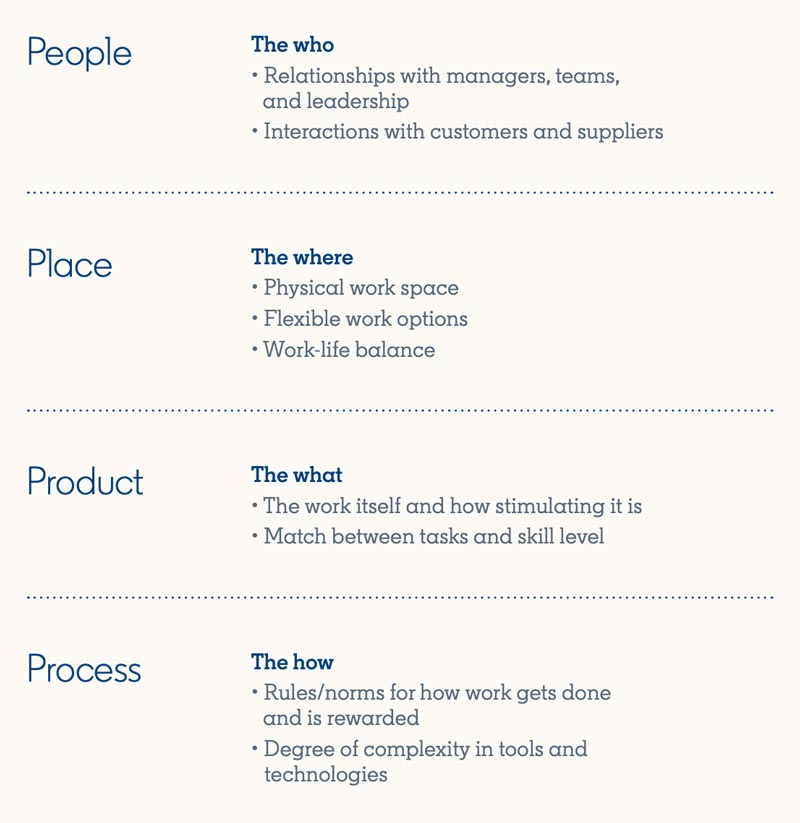Today’s employee experience is not what people were promised. The employee experience today, with social distancing, distributed teams, and different expectations, is a far cry from what most of our employees have come to expect and rely upon.
While some workers are happy with remote work, many had been very pleased to be anchored to the routine of a daily commute and the ability to walk out at the end of the workday.
Maybe your team was wooed with dynamic workspaces that included specialty brews on tap and artisanal coffee. Most were not prepared for an entirely remote organization, relying on video conferencing and at-home headsets.
These employees are the engine that keeps your entire organization – including your customer experience – running. And while many team leaders are doing a great job checking in with individual employees, it’s time to revisit the entire employee experience in most organizations.
Employee experience as a business discipline has been maturing just behind customer experience. More organizations are investing in the overall experience of employees, by following similar best practices from customer experience. Instead of just checking in with employees for an annual survey, progressive leaders are using tools and techniques to help attract, retain, and develop the employees who are most capable and willing to live their mission:

The Four P’s, via the 2020 LinkedIn Global Talent Trends Report.
Customer experience is directly connected to employee experience. The best customer experiences are delivered by engaged, solutions-oriented employees. These employees understand the overall CX mission and their role to deliver on that.
The 2020 LinkedIn Global Talent Trends Report identified four core components of employee experience: People, Place, Product, and Process. I’d add one more to this list, which is Purpose.
I’ve been interviewing employees, executive teams to call center agents and everyone in between, for more than a decade as part of the CXI® consulting we provide. The employees who care the most and want the best for the company, their colleagues and their customers have told me how critical it is for them to know their purpose. They want to be part of providing experiences that help live this mission and understand their purpose as part of it.
Based on what we knew before and what we know now, here are a few ideas to revisit your employee experience to ensure your best employees stay positive, productive, and customer-centric!
We’ve been talking a lot about building and maintaining customer trust. Well, employee trust is a huge part of that.
What did you promise before? Everybody understands that circumstances have rearranged our promises, but there are still things you can guarantee your team:
Find the promises you made before and reiterate that you continue to stand by them today.
What can you promise now? Your employees probably need some reassurance, and it can be tempting to over-promise in order to reassure your employees. Avoid the urge.
The strength of our promises is equal to our ability to keep those promises. With each promise we fail to keep, our word loses meaning. While over-promising might lift your employees’ spirits in the short-term, limiting your promises to those you know can be kept will help employees in the long run… and it’s what they deserve.
Maybe the only promise we can make is around how often, and how authentically, leaders will communicate. Stand by that promise and hold leaders accountable.
Employee Experience Tip: The strength of our promises is equal to our ability to keep those promises. We must make only the promises we know we can keep… it’s what our employees deserve.
Asking employees about their long-term goals right now might be well-intentioned but superfluous. If there isn’t a way to address employees’ answers, or even optimistically plan for an employee development plan due to short-term survival, then asking is wasting time and energy. Streamline your employee surveys to include what you NEED to know and what the organization can actually act on.
Be upfront and honest about this approach with employees. Let them know you’re asking the most critical questions to stay focused and realistic. And wherever you can, provide the most relevant questions for the role. Context is crucial.
Employee Experience Tip: Streamline employee surveys to ask what you NEED to know now. Asking about long-term goals may be well-intentioned, but superfluous.
Relationships with colleagues are an important part of the social aspect of any workplace. It’s nice to offer space for employees to share more than just business. Some employees, especially right now, are challenged with attending every virtual meeting and Zoom happy hour as they balance their personal needs.
Get creative by allowing a few different ways to do this, including encouraging one-on-one conversations instead of the group Zoom call when appropriate.
And remember, not all social interactions require every single teammate. It might be more important for that employee to go for a run outside during that time to maintain a positive attitude. Allow some grace and personal choice when it comes to team building right now.
Collaborative tools like Microsoft Teams or Slack can be enough for some people to feel connected and engaged.
Employee Experience Tip: Not all social interactions require every single teammate. It might be more important for an employee to go for a run outside than to join a team-building zoom call. Allow some grace and personal choice.
Like customer journeys, employee journeys help us understand an entire relationship, not just individual interactions or experiences.
Some organizations have detailed employee journey maps from the candidate experience through hiring through exit interviews. Existing employee journey maps are a great resource, but today it’s critical to map the new journey employees face.
These are big questions and obvious moments that matter to your employee journey. Identify these key moments that matter along TODAY’S employee journey to find opportunities to improve the experience.
Employee Experience Tip: Existing employee journey maps are a great resource, but today it’s critical to map the new journey employees face. Identify today’s employee journey, not the one from last year.
Employee journey maps of the past often segmented employees by their roles or departments in the organization. Today, your employees are finding their overall life stages and responsibilities impacting their work.
These life factors are front and center for your employees, so it’s time to look for best practices to support them.
Employee journey maps for these types of segments can help you hone in on the moments that matter most to them. It’s also a great way to connect employees who might otherwise feel isolated in their challenges. I recently saw a client create special Slack channels for these groups as they were identified.
They are there just to provide help and connection for these employees dealing with very real challenges.
Employee Experience Tip: Group employees by what they’re experiencing right now… make it easy for them to support one-another.
Your employees are dealing with very real and NEW challenges right now. Many teams have settled into rhythms and schedules that can feel comfortable. It can feel like things are working, but just like at any workplace, things can shift quickly.
Invest in really listening to your employees and creating proactive experiences to help them. The journey maps and outcomes created during this temporary situation will still provide long-term value and outcomes.
Oh – and don’t forget to thank your employees for all they do. Look for times to “catch them doing something right” and make a big deal out of it.
Small victories with big celebrations can go a long way right now. That might be the moment that matters most. Gratitude is always an appropriate action.
 Jeannie is an award-winning customer experience expert, international keynote speaker, and sought-after business coach who is trailblazing the movement from “Reactive Customer Service” to “Proactive Customer and Employee Experience.” More than 500,000 people have learned from her CX courses on LinkedIn Learning, and her insights have been featured in Forbes, The Chicago Tribune, The Wall Street Journal and NPR.
Get Jeannie’s insights in your inbox each week by subscribing to The Weekly Win and follow her on LinkedIn, Instagram and YouTube.
Jeannie is an award-winning customer experience expert, international keynote speaker, and sought-after business coach who is trailblazing the movement from “Reactive Customer Service” to “Proactive Customer and Employee Experience.” More than 500,000 people have learned from her CX courses on LinkedIn Learning, and her insights have been featured in Forbes, The Chicago Tribune, The Wall Street Journal and NPR.
Get Jeannie’s insights in your inbox each week by subscribing to The Weekly Win and follow her on LinkedIn, Instagram and YouTube.